Study on Groundwater Function Zoning and Sustainable Development and Utilization in Jining City Planning Area
Abstract
:1. Introduction
2. Materials and Methods
2.1. Study Area
2.2. Technical Route
2.3. Analytic Hierarchy Process
2.4. Principle of Comprehensive Zoning for Groundwater Functions
2.5. Groundwater Function
2.5.1. Resource Supply Function
Groundwater Quantity
Groundwater Quality
2.5.2. Geo-Environmental Stability Function
Thickness of Soft Soil Stratum (T)
Depth of Groundwater (D)
Land Use (U)
Distance to Fault (F)
2.5.3. Ecological Environment Function
Water Conservation
Ecological Protection
3. Results
3.1. Resource Supply Function
3.2. Geo-Environmental Stabilization Function
3.3. Ecological Environment Function
3.4. Comprehensive Zoning of Groundwater Functions
4. Discussion
4.1. Characteristics of Comprehensive Zoning of Groundwater Functions
4.2. Verification of Groundwater Functional Zoning
4.3. Suggestions for Sustainable Groundwater Development
- (1)
- Unsuitable development and utilization zones: These zones are primarily located in the eastern part of Jiaxiang County, the southern part of Rencheng District, and the bordering areas with Yanzhou District. These areas have poor groundwater quality with significant pollutant exceedances. Most areas, except for Yanzhou District, also face low groundwater quantity and limited groundwater recharge due to surface sealing caused by concentrated urban development. Therefore, the extraction of shallow groundwater resources should be prohibited in these areas, and corresponding measures for ecological environment restoration should be implemented.
- (2)
- Ecological protection zones: These zones are mainly distributed within national (provincial, municipal) ecological protection areas, wetland parks, and lake–reservoir-type drinking water sources, representing typical ecological protection areas. To maintain ecological and geo-environmental stability in these areas, the large-scale exploitation and utilization of groundwater resources should be avoided. It is recommended to control the intensity of extraction during development and utilization, ensuring the relative stability of groundwater levels, maintaining a reasonable ecological water level, and avoiding ecosystem degradation. For areas with good water quality, the aim is to maintain the existing water quality, while for areas affected by pollution, protection and restoration measures should be prioritized.
- (3)
- Fragile geo-environmental zones: It is recommended to control the intensity of extraction during development and utilization, ensuring the relative stability of groundwater levels and avoiding geo-environmental issues. For areas with good water quality, the aim is to maintain the existing water quality, while for areas affected by pollution, the target is to restore the natural water quality before contamination.
- (4)
- Groundwater supply zones: These zones include concentrated development and utilization areas as well as scattered development areas, where groundwater can meet the demands for drinking, agricultural, and industrial water use. It is recommended to control the volume of groundwater extraction and ensure that groundwater levels do not continuously decline during extraction, avoiding ecosystem degradation and environmental geological issues. These zones can be considered reliable groundwater supply areas.
4.4. Limitation
5. Conclusions
Author Contributions
Funding
Institutional Review Board Statement
Informed Consent Statement
Data Availability Statement
Acknowledgments
Conflicts of Interest
References
- Gholami, V.; Yousefi, Z.; Zabardast Rostami, H. Modeling of Ground Water Salinity on the Caspian Southern Coasts. Water Resour. Manag. 2010, 24, 1415–1424. [Google Scholar] [CrossRef]
- Margat, J.; Van der Gun, J. Groundwater around the World: A Geographic Synopsis; CRC Press: Boca Raton, FL, USA, 2013. [Google Scholar]
- Hao, A.; Zhang, Y.; Zhang, E.; Li, Z.; Yu, J.; Huang, W.; Yang, J.; Wang, Y. Groundwater resources and related environmental issues in China. Hydrogeol. J. 2018, 26, 1325–1337. [Google Scholar] [CrossRef]
- Jakeman, A.J.; Barreteau, O.; Hunt, R.J.; Rinaudo, J.-D.; Ross, A. Integrated Groundwater Management; Springer Nature: Berlin/Heidelberg, Germany, 2016. [Google Scholar]
- Saidi, S.; Bouri, S.; Dhia, H.B.; Anselme, B. Assessment of groundwater risk using intrinsic vulnerability and hazard mapping: Application to Souassi aquifer, Tunisian Sahel. Agric. Water Manag. 2011, 98, 1671–1682. [Google Scholar] [CrossRef]
- Yazdian, M.; Rakhshandehroo, G.; Nikoo, M.R.; Mooselu, M.G.; Gandomi, A.H.; Honar, T. Groundwater sustainability: Developing a non-cooperative optimal management scenario in shared groundwater resources under water bankruptcy conditions. J. Environ. Manag. 2021, 292, 112807. [Google Scholar] [CrossRef] [PubMed]
- Li, J.; Liu, H.; Su, Z.; Fan, X. Changes in wind activity from 1957 to 2011 and their possible influence on aeolian desertification in northern China. J. Arid. Land 2015, 7, 755–764. [Google Scholar] [CrossRef]
- Xiong, H.; Wang, Y.; Guo, X.; Han, J.; Ma, C.; Zhang, X. Current status and future challenges of groundwater vulnerability assessment: A bibliometric analysis. J. Hydrol. 2022, 615, 128694. [Google Scholar] [CrossRef]
- Ahmad, A.Y.; Al-Ghouti, M.A. Approaches to achieve sustainable use and management of groundwater resources in Qatar: A review. Groundw. Sustain. Dev. 2020, 11, 100367. [Google Scholar] [CrossRef]
- Choudhary, S.; Pingale, S.M.; Khare, D. Delineation of groundwater potential zones of upper Godavari sub-basin of India using bi-variate, MCDM and advanced machine learning algorithms. Geocarto Int. 2022, 37, 15063–15093. [Google Scholar] [CrossRef]
- Konikow, L.F.; Kendy, E. Groundwater depletion: A global problem. Hydrogeol. J. 2005, 13, 317–320. [Google Scholar] [CrossRef]
- Shyam, M.; Meraj, G.; Kanga, S.; Sudhanshu; Farooq, M.; Singh, S.K.; Sahu, N.; Kumar, P. Assessing the Groundwater Reserves of the Udaipur District, Aravalli Range, India, Using Geospatial Techniques. Water 2022, 14, 648. [Google Scholar] [CrossRef]
- Zhang, J. Discussion on Several Problems in the Development and Utilization of Water Resources in Groundwater Excessive Exploitation Areas. Groundwater 2005, 27, 118–120. [Google Scholar]
- Gao, X.; Wang, S.; Liu, P. Discussion on Groundwater Problems and Countermeasures. Shanxi Water Conserv. 2005, 21, 23. [Google Scholar]
- Lin, X.; Liao, Z. The essential attributes and functions of groundwater resources and the significance of hydrogeological research. J. Tianjin Univ. Soc. Sci. Ed. 2004, 6, 193–195. [Google Scholar]
- Tang, K.; Du, Q. Discussion on the Division of Groundwater Functional Areas. Water Resour. Prot. 2004, 20, 16–19. [Google Scholar]
- Li, F.; Zhao, Y.; Feng, P.; Zhang, W.; Qiao, J. Risk assessment of groundwater and its application. Part I: Risk grading based on the functional zoning of groundwater. Water Resour. Manag. 2015, 29, 2697–2714. [Google Scholar] [CrossRef]
- Alley, W.M.; Reilly, T.E.; Franke, O.L. Sustainability of Ground-Water Resources; US Department of the Interior, US Geological Survey: Reston, VA, USA, 1999.
- Raghavendra, N.S.; Deka, P.C. Sustainable development and management of groundwater resources in mining affected areas: A review. Procedia Earth Planet. Sci. 2015, 11, 598–604. [Google Scholar] [CrossRef]
- Steele, K.; Carmel, Y.; Cross, J.; Wilcox, C. Uses and misuses of multicriteria decision analysis (MCDA) in environmental decision making. Risk Anal. Int. J. 2009, 29, 26–33. [Google Scholar] [CrossRef]
- Janssen, R. Multiobjective Decision Support for Environmental Management; Kluwer Academic Publishers: Dordrecht, The Netherlands, 1992; p. 232. [Google Scholar]
- Vaidya, O.S.; Kumar, S. Analytic hierarchy process: An overview of applications. Eur. J. Oper. Res. 2006, 169, 1–29. [Google Scholar] [CrossRef]
- Swetha, T.; Gopinath, G.; Thrivikramji, K.; Jesiya, N. Geospatial and MCDM tool mix for identification of potential groundwater prospects in a tropical river basin, Kerala. Environ. Earth Sci. 2017, 76, 428. [Google Scholar] [CrossRef]
- Shekhar, S.; Pandey, A.C. Delineation of groundwater potential zone in hard rock terrain of India using remote sensing, geographical information system (GIS) and analytic hierarchy process (AHP) techniques. Geocarto Int. 2015, 30, 402–421. [Google Scholar] [CrossRef]
- Scheihing, K.W.; Kübeck, C.; Sütering, U. GIS-AHP Ensembles for Multi-Actor Multi-Criteria Site Selection Processes: Application to Groundwater Management under Climate Change. Water 2022, 14, 1793. [Google Scholar] [CrossRef]
- Shao, Z.; Huq, M.E.; Cai, B.; Altan, O.; Li, Y. Integrated remote sensing and GIS approach using Fuzzy-AHP to delineate and identify groundwater potential zones in semi-arid Shanxi Province, China. Environ. Model. Softw. 2020, 134, 104868. [Google Scholar] [CrossRef]
- Neshat, A.; Pradhan, B.; Dadras, M. Groundwater vulnerability assessment using an improved DRASTIC method in GIS. Resour. Conserv. Recycl. 2014, 86, 74–86. [Google Scholar] [CrossRef]
- Singh, L.K.; Jha, M.K.; Chowdary, V.M. Assessing the accuracy of GIS-based Multi-Criteria Decision Analysis approaches for mapping groundwater potential. Ecol. Indic. 2018, 91, 24–37. [Google Scholar] [CrossRef]
- Farhat, B.; Souissi, D.; Mahfoudhi, R.; Chrigui, R.; Sebei, A.; Ben Mammou, A. GIS-based multi-criteria decision-making techniques and analytical hierarchical process for delineation of groundwater potential. Environ. Monit. Assess. 2023, 195, 285. [Google Scholar] [CrossRef]
- Tweed, S.O.; Leblanc, M.; Webb, J.A.; Lubczynski, M.W. Remote sensing and GIS for mapping groundwater recharge and discharge areas in salinity prone catchments, southeastern Australia. Hydrogeol. J. 2007, 15, 75–96. [Google Scholar] [CrossRef]
- Yeh, H.-F.; Lee, C.-H.; Hsu, K.-C.; Chang, P.-H. GIS for the assessment of the groundwater recharge potential zone. Environ. Geol. 2009, 58, 185–195. [Google Scholar] [CrossRef]
- Mukherjee, S. Targeting saline aquifer by remote sensing and geophysical methods in a part of Hamirpur-Kanpur, India. Hydrogeol. J. 1996, 19, 53–64. [Google Scholar]
- Xiong, H.; Ma, C.; Li, M.; Tan, J.; Wang, Y. Landslide susceptibility prediction considering land use change and human activity: A case study under rapid urban expansion and afforestation in China. Sci. Total Environ. 2023, 866, 161430. [Google Scholar] [CrossRef] [PubMed]
- Gautam, A.; Rai, S.C.; Rai, S.P. Assessment of Groundwater Quality beneath Agriculturally Advanced Region of Northern Alluvial Plain, India. Sustainability 2021, 13, 7053. [Google Scholar] [CrossRef]
- Lee, S. Determination of Priority Weights under Multiattribute Decision-Making Situations: AHP versus Fuzzy AHP. J. Constr. Eng. Manag. 2015, 141, 05014015. [Google Scholar] [CrossRef]
- Mudashiru, R.B.; Sabtu, N.; Abdullah, R.; Saleh, A.; Abustan, I. A comparison of three multi-criteria decision-making models in mapping flood hazard areas of Northeast Penang, Malaysia. Nat. Hazards 2022, 112, 1903–1939. [Google Scholar] [CrossRef]
- Yu, C.-S. A GP-AHP method for solving group decision-making fuzzy AHP problems. Comput. Oper. Res. 2002, 29, 1969–2001. [Google Scholar] [CrossRef]
- Chen, C.-H. A Novel Multi-Criteria Decision-Making Model for Building Material Supplier Selection Based on Entropy-AHP Weighted TOPSIS. Entropy 2020, 22, 259. [Google Scholar] [CrossRef] [PubMed]
- Feng, G.; Lei, S.; Guo, Y.; Meng, B.; Jiang, Q. Optimization and Evaluation of Ventilation Mode in Marine Data Center Based on AHP-Entropy Weight. Entropy 2019, 21, 796. [Google Scholar] [CrossRef] [PubMed]
- Khare, Y.D.; Varade, A.M. Approach to Groundwater Management towards Sustainable Development in India. Acque Sotter.-Ital. J. Groundw. 2018, 7. [Google Scholar] [CrossRef]
- Guo, X.; Ma, C.; Hu, X.; Hu, X.; Yan, W. Application of groundwater functional zoning to coastal groundwater management: A case study in the plain area of Weifang City, China. Environ. Earth Sci. 2019, 78, 525. [Google Scholar] [CrossRef]
- Wang, S.; Liu, H.; Zhao, W.; Li, Z. Groundwater Sustainability in Arid and Semi-arid Environments: A Review2. Adv. Earth Sci. 2019, 34, 210. [Google Scholar]
- Jacobs, K.L.; Holway, J.M. Managing for sustainability in an arid climate: Lessons learned from 20 years of groundwater management in Arizona, USA. Hydrogeol. J. 2004, 12, 52–65. [Google Scholar] [CrossRef]
- Brown, M. Managing California’s Water: A Look at the Sustainable Groundwater Management Act of 2014. Hastings W.-Nw. J. Envt’l L. Pol’y. 2017, 23, 1. [Google Scholar]
- Hosseini, S.M.; Parizi, E.; Ataie-Ashtiani, B.; Simmons, C.T. Assessment of sustainable groundwater resources management using integrated environmental index: Case studies across Iran. Sci. Total Environ. 2019, 676, 792–810. [Google Scholar] [CrossRef]
- Mititelu-Ionuş, O. Watershed Sustainability Index Development and Application: Case Study of the Motru River in Romania. Pol. J. Environ. Stud. 2017, 26, 2095–2105. [Google Scholar] [CrossRef] [PubMed]
- Kang, M.G.; Lee, G.M. Multicriteria Evaluation of Water Resources Sustainability in the Context of Watershed Management 1. JAWRA J. Am. Water Resour. Assoc. 2011, 47, 813–827. [Google Scholar] [CrossRef]
- Jha, M.K.; Chowdhury, A.; Chowdary, V.; Peiffer, S. Groundwater management and development by integrated remote sensing and geographic information systems: Prospects and constraints. Water Resour. Manag. 2007, 21, 427–467. [Google Scholar] [CrossRef]
- Haile, M.M.; Tafesse Yadeta, J.; Amena Gambe, L. Delineation of groundwater potential zones using geo-spatial and AHP techniques: Ambo area, Blue Nile Basin, Ethiopia. Sustain. Water Resour. Manag. 2022, 8, 36. [Google Scholar] [CrossRef]
- Prasad, R.; Mondal, N.; Banerjee, P.; Nandakumar, M.; Singh, V. Deciphering potential groundwater zone in hard rock through the application of GIS. Environ. Geol. 2008, 55, 467–475. [Google Scholar] [CrossRef]
- Gupta, D.S.; Biswas, A.; Ghosh, P.; Rawat, U.; Tripathi, S. Delineation of groundwater potential zones, groundwater estimation and recharge potentials from Mahoba district of Uttar Pradesh, India. Int. J. Environ. Sci. Technol. 2022, 19, 12145–12168. [Google Scholar] [CrossRef]
- Soleimani-Motlagh, M.; Ghasemieh, H.; Talebi, A.; Abdollahi, K.; Dragoni, W. Groundwater budget deficit caused by drought and overexploitation. Water Supply 2020, 20, 621–632. [Google Scholar] [CrossRef]
- Wu, Y.; Zhao, S. Status quo and change characteristics of groundwater resources pollution in the Hami region based on sustainable development strategies. Water Supply 2023, 23, 1478–1494. [Google Scholar] [CrossRef]
- Lu, H.; Li, H.; Wang, J.; Zheng, H.; Cao, X.; Tong, C. Optimal water and land resource allocation in pastoral areas based on a water–land forage–livestock balance: A case study of Otog Front Banner, Inner Mongolia, China. Environ. Sci. Pollut. Res. 2020, 27, 10328–10341. [Google Scholar] [CrossRef]
- Ling, M.; Han, H.; Wei, X.; Lv, C. Temporal and spatial distributions of precipitation on the Huang-Huai-Hai Plain during 1960–2019, China. J. Water Clim. Change 2021, 12, 2232–2244. [Google Scholar] [CrossRef]
- Zhou, C.; Zhang, R.; Ning, X.; Zheng, Z. Spatial-Temporal Characteristics in Grain Production and Its Influencing Factors in the Huang-Huai-Hai Plain from 1995 to 2018. Int. J. Environ. Res. Public Health 2020, 17, 9193. [Google Scholar] [CrossRef] [PubMed]
- Ong′or, B.T.I.; Shu, L.C.; Liu, P.G. Environmental impact assessment of risk associated with groundwater overdraft remediation in cone of depression, Jining, China. Environ. Geol. 2007, 53, 751–762. [Google Scholar] [CrossRef]
- Saaty, T.L. The Analytical Hierarchy Process, Planning, Priority; Resource Allocation; RWS Publications: Pittsburgh, PA, USA, 1980. [Google Scholar]
- Wu, X.; Li, B.; Ma, C. Assessment of groundwater vulnerability by applying the modified DRASTIC model in Beihai City, China. Environ. Sci. Pollut. Res. 2018, 25, 12713–12727. [Google Scholar] [CrossRef] [PubMed]
- Zhao, J.-W.; Peng, F.-L.; Wang, T.-Q.; Zhang, X.-Y.; Jiang, B.-N. Advances in master planning of urban underground space (UUS) in China. Tunn. Undergr. Space Technol. 2016, 55, 290–307. [Google Scholar] [CrossRef]
- Arabameri, A.; Saha, S.; Roy, J.; Tiefenbacher, J.P.; Cerda, A.; Biggs, T.; Pradhan, B.; Ngo, P.T.T.; Collins, A.L. A novel ensemble computational intelligence approach for the spatial prediction of land subsidence susceptibility. Sci. Total Environ. 2020, 726, 138595. [Google Scholar] [CrossRef]
- Bekesi, G.; Hodges, S. The protection of groundwater dependent ecosystems in Otago, New Zealand. Hydrogeol. J. 2006, 14, 1696–1701. [Google Scholar] [CrossRef]
- Münch, Z.; Conrad, J. Remote sensing and GIS based determination of groundwater dependent ecosystems in the Western Cape, South Africa. Hydrogeol. J. 2007, 15, 19–28. [Google Scholar] [CrossRef]
- Erostate, M.; Huneau, F.; Garel, E.; Ghiotti, S.; Vystavna, Y.; Garrido, M.; Pasqualini, V. Groundwater dependent ecosystems in coastal Mediterranean regions: Characterization, challenges and management for their protection. Water Res. 2020, 172, 115461. [Google Scholar] [CrossRef]
- Sun, L.; Ma, C.; Li, Y. Multiple geo-environmental hazards susceptibility assessment: A case study in Luoning County, Henan Province, China. Geomat. Nat. Hazards Risk 2019, 10, 2009–2029. [Google Scholar] [CrossRef]
- Yu, H.; Wu, Q.; Zeng, Y.; Zheng, L.; Xu, L.; Liu, S.; Wang, D. Integrated variable weight model and improved DRASTIC model for groundwater vulnerability assessment in a shallow porous aquifer. J. Hydrol. 2022, 608, 127538. [Google Scholar] [CrossRef]
- Arshad, A.; Zhang, Z.; Zhang, W.; Dilawar, A. Mapping favorable groundwater potential recharge zones using a GIS-based analytical hierarchical process and probability frequency ratio model: A case study from an agro-urban region of Pakistan. Geosci. Front. 2020, 11, 1805–1819. [Google Scholar] [CrossRef]
- Jothibasu, A.; Anbazhagan, S. Hydrogeological assessment of the groundwater aquifers for sustainability state and development planning. Environ. Earth Sci. 2018, 77, 88. [Google Scholar] [CrossRef]


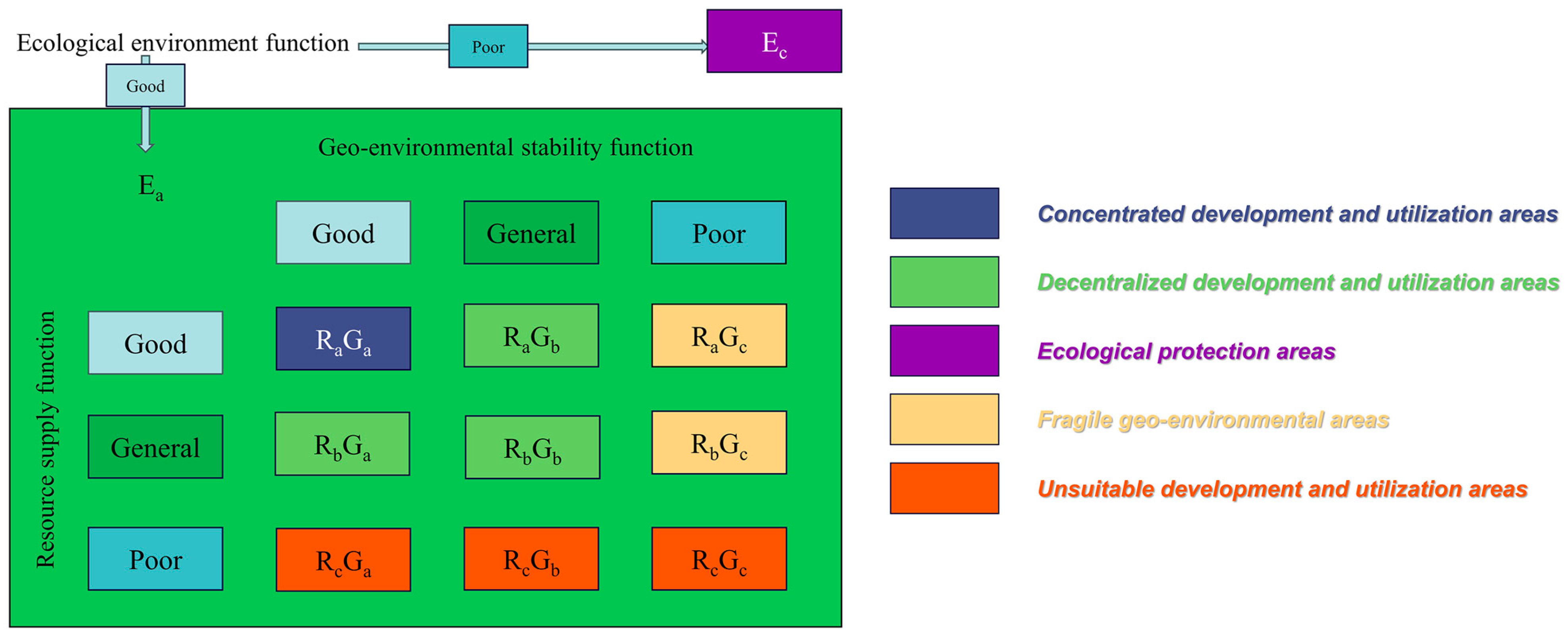
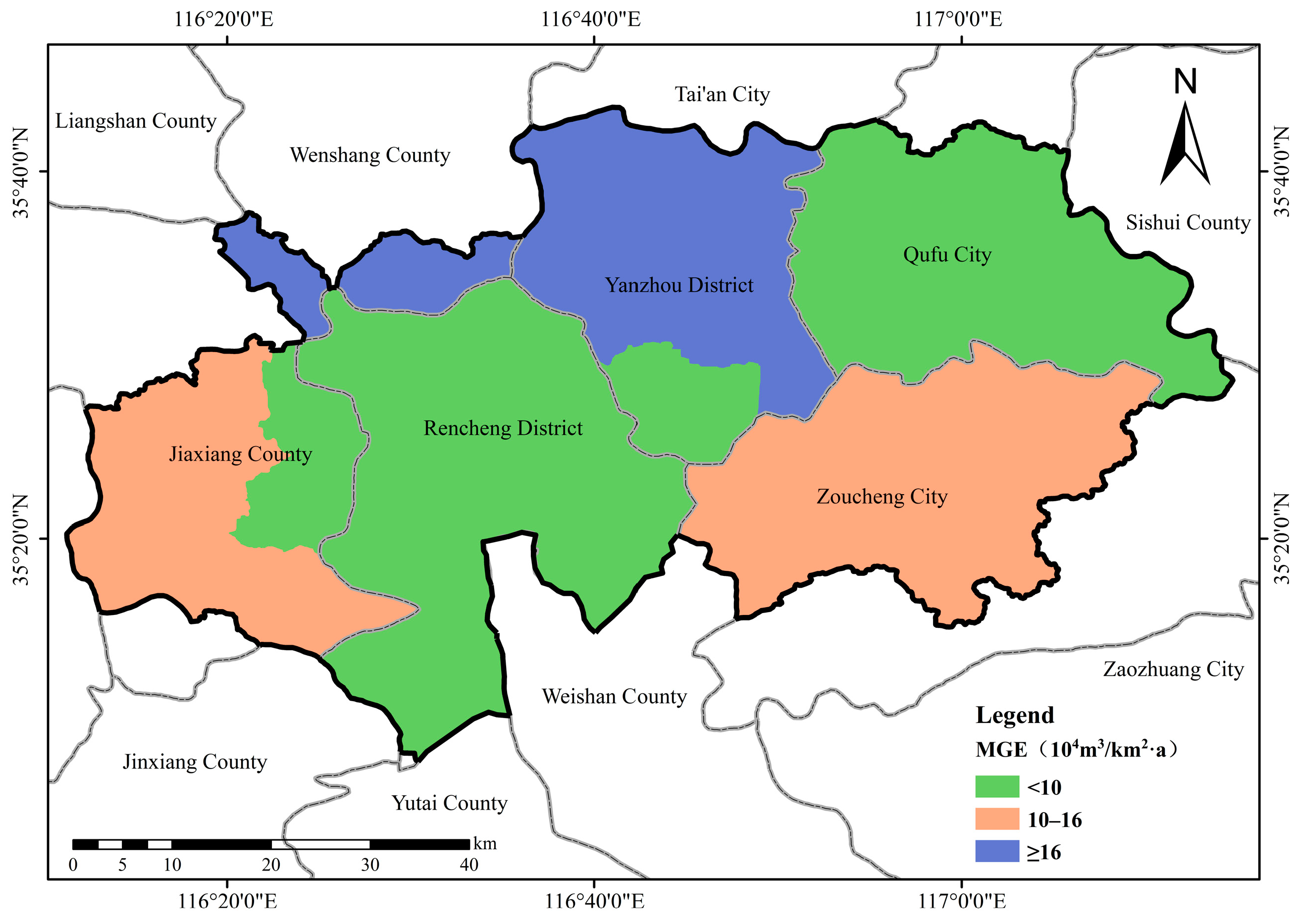
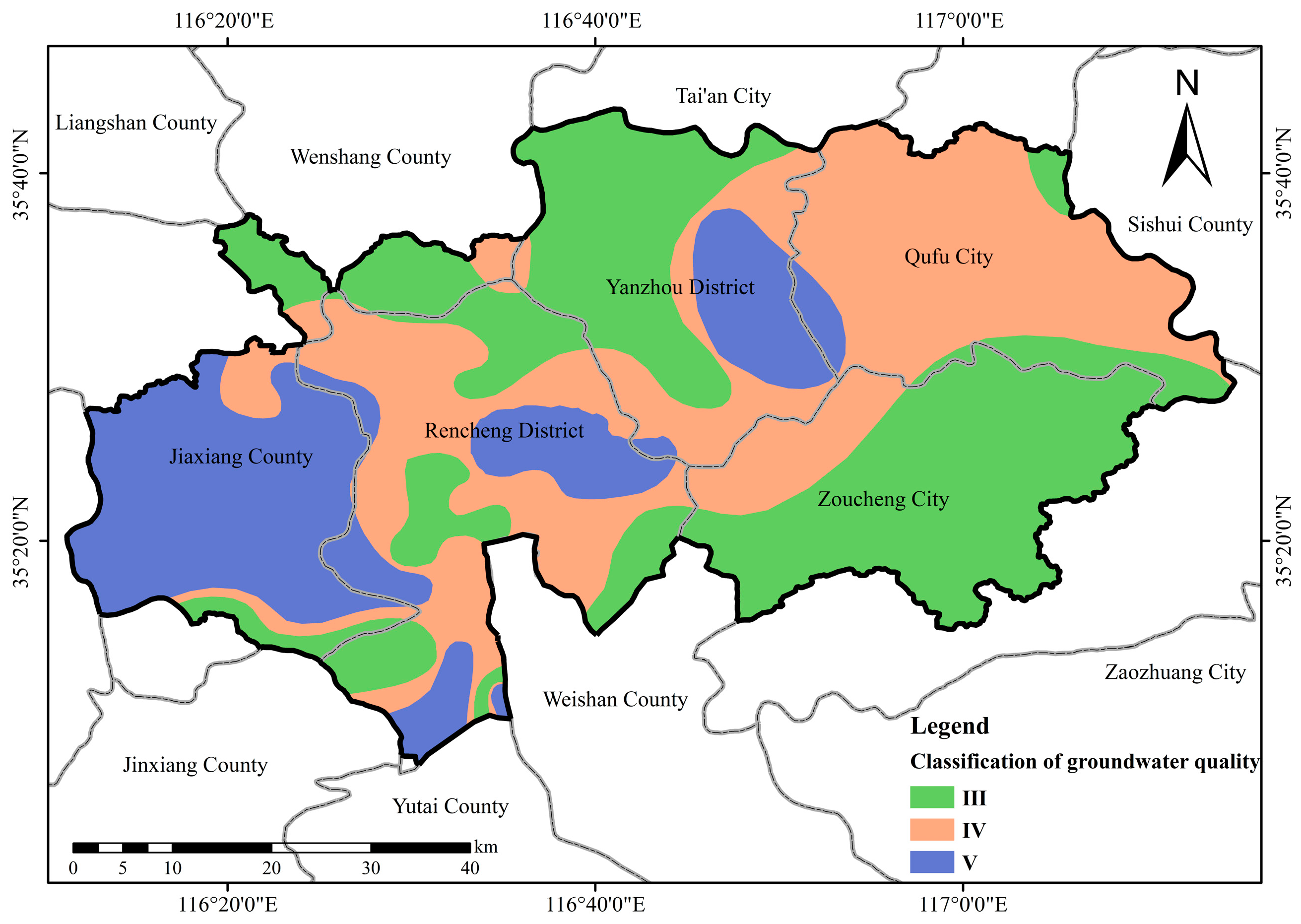
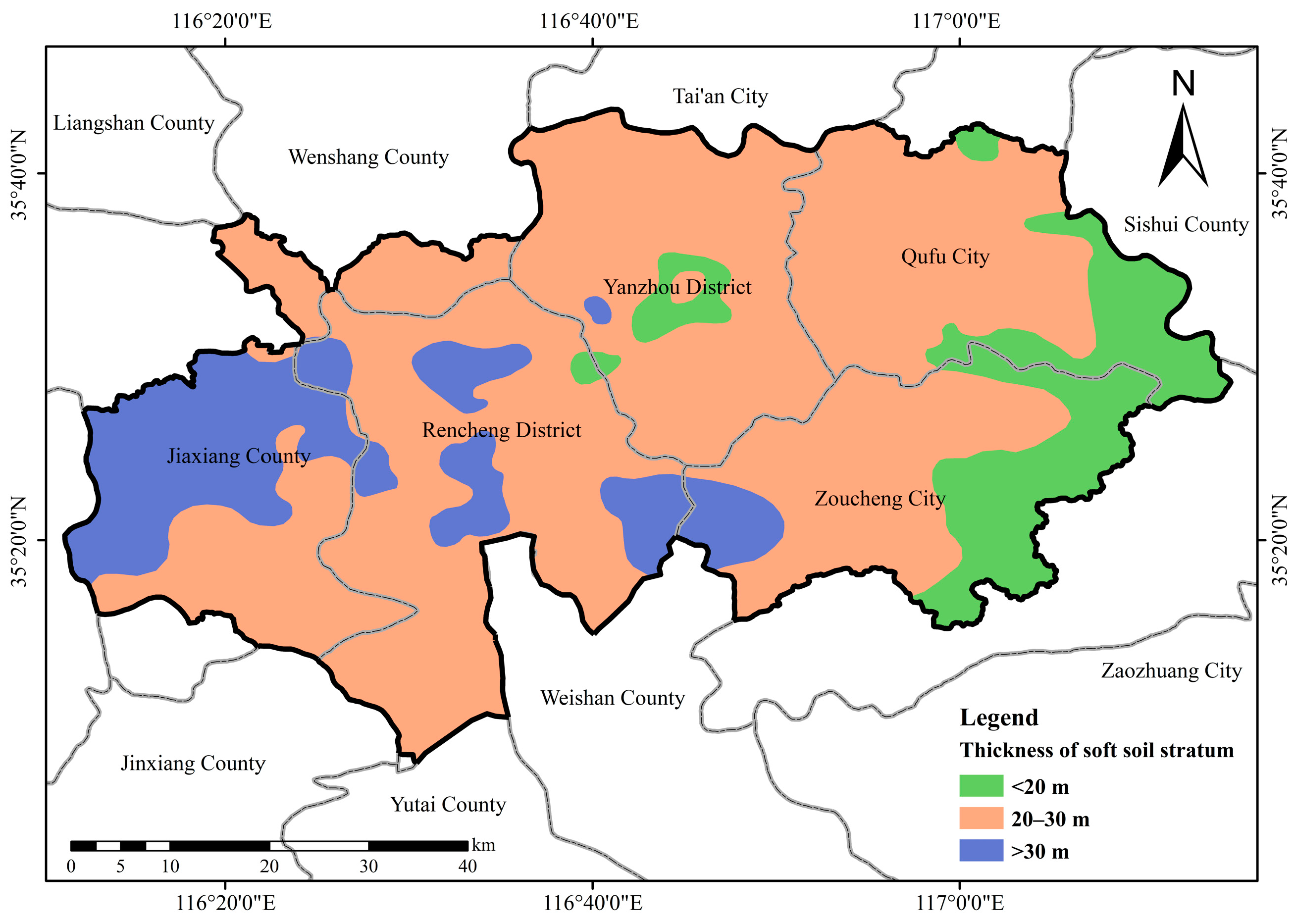
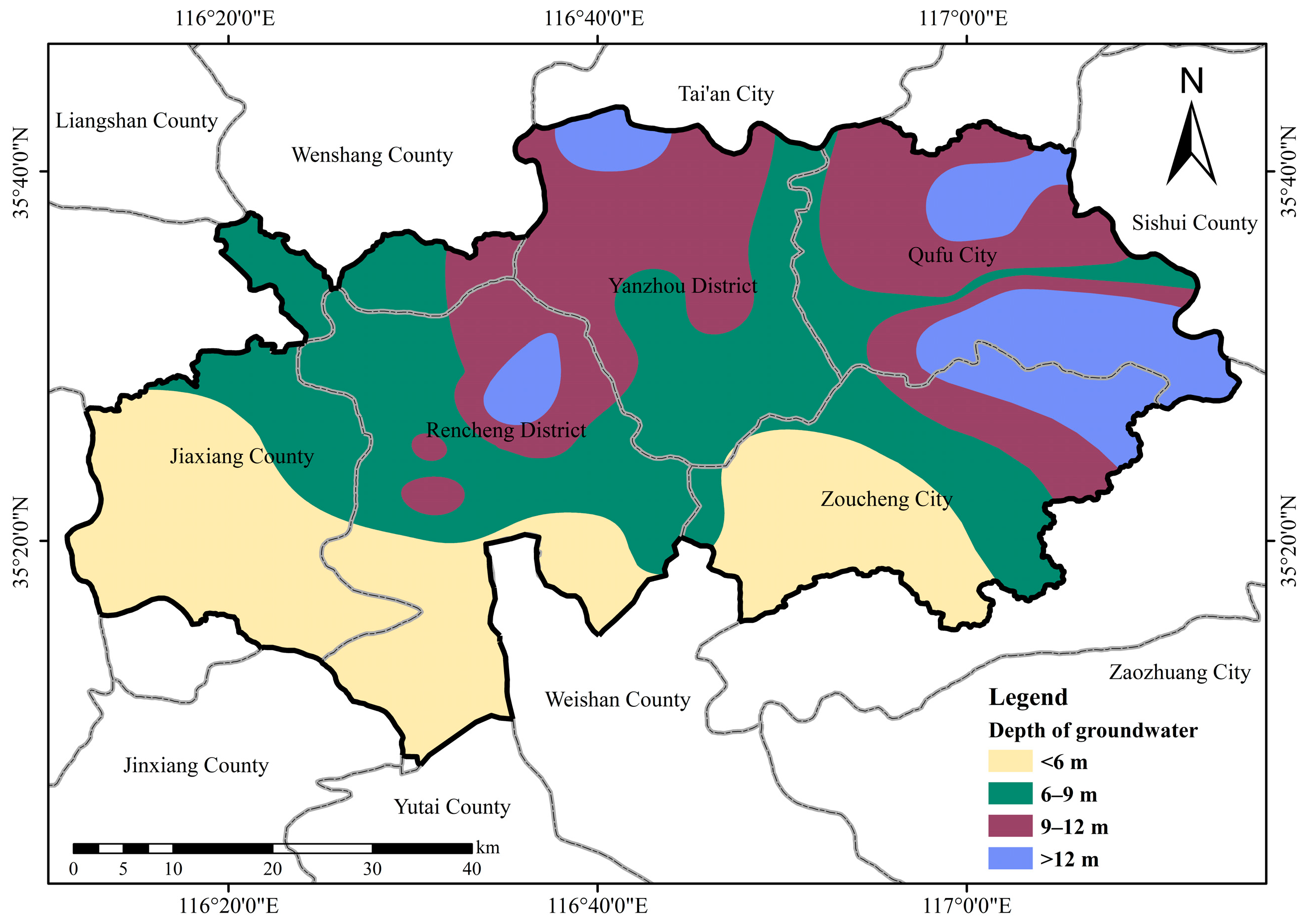





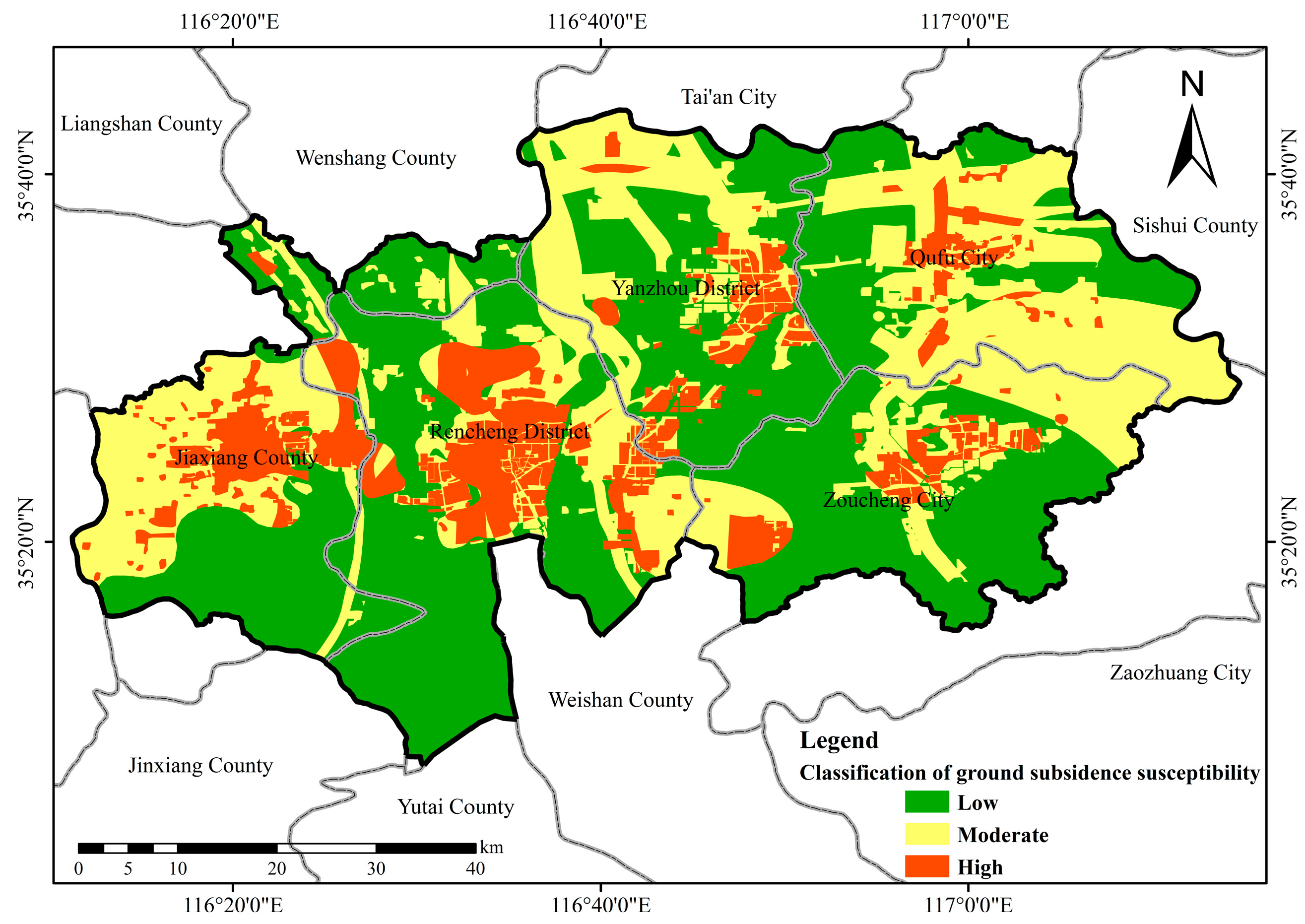
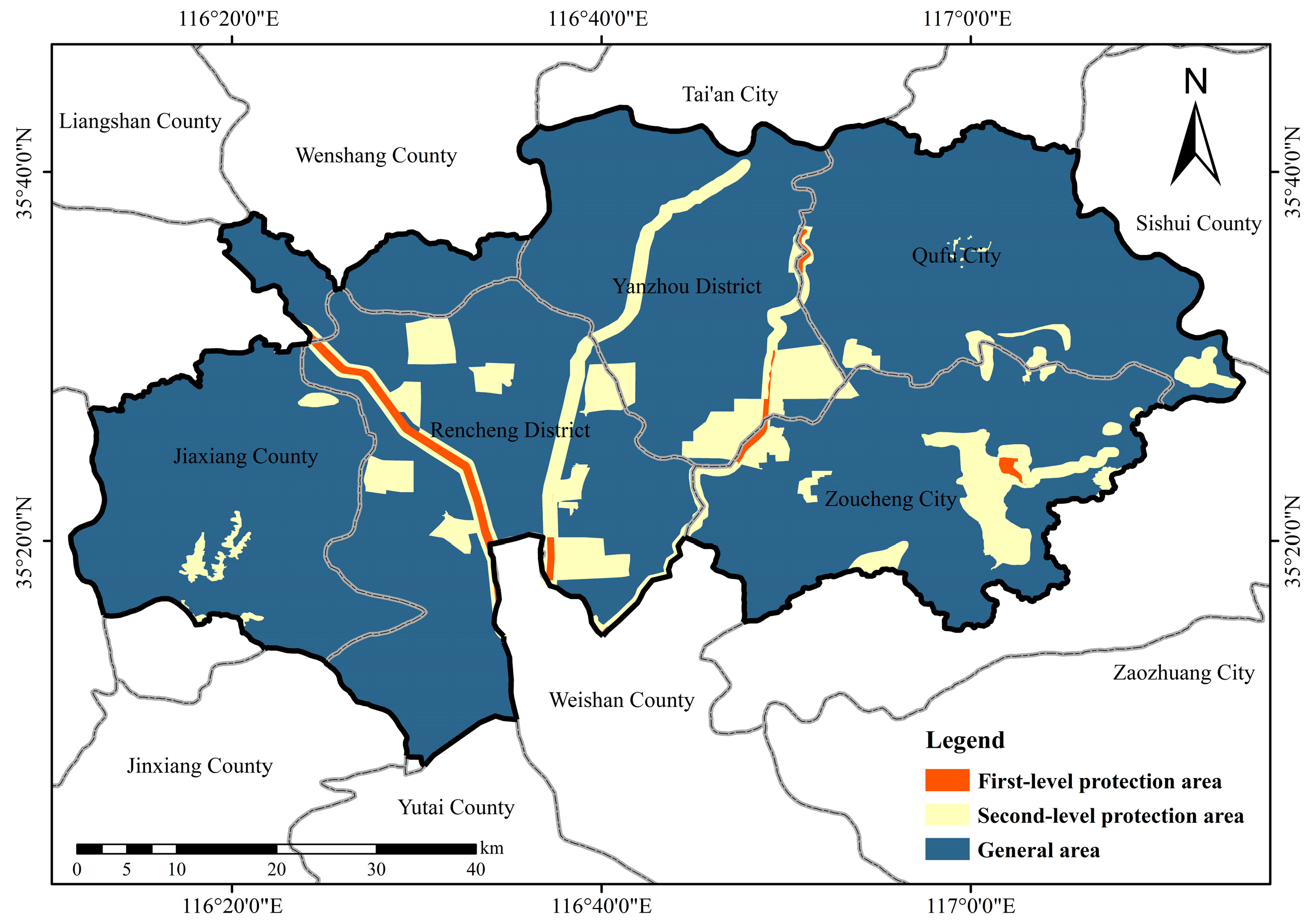
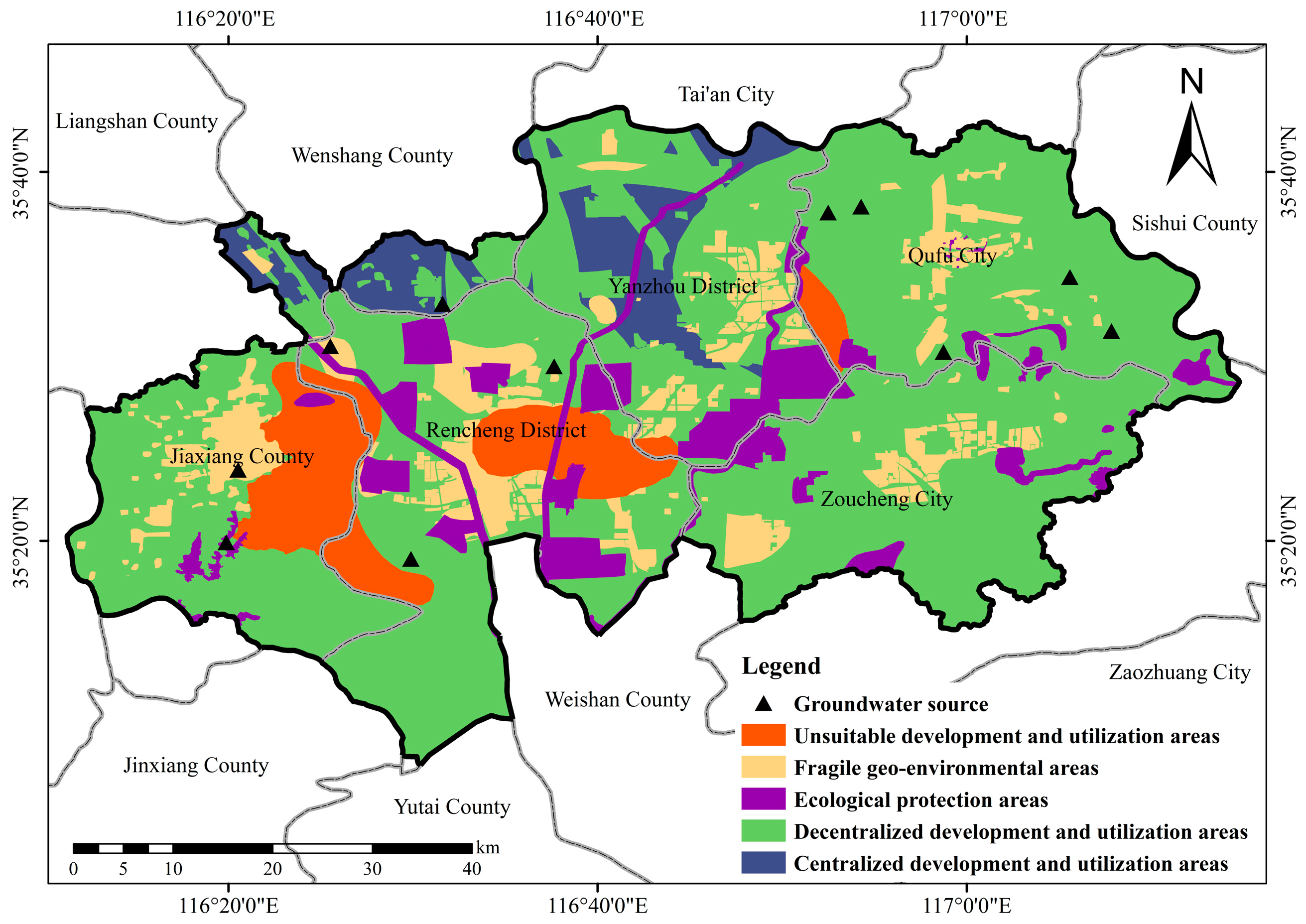
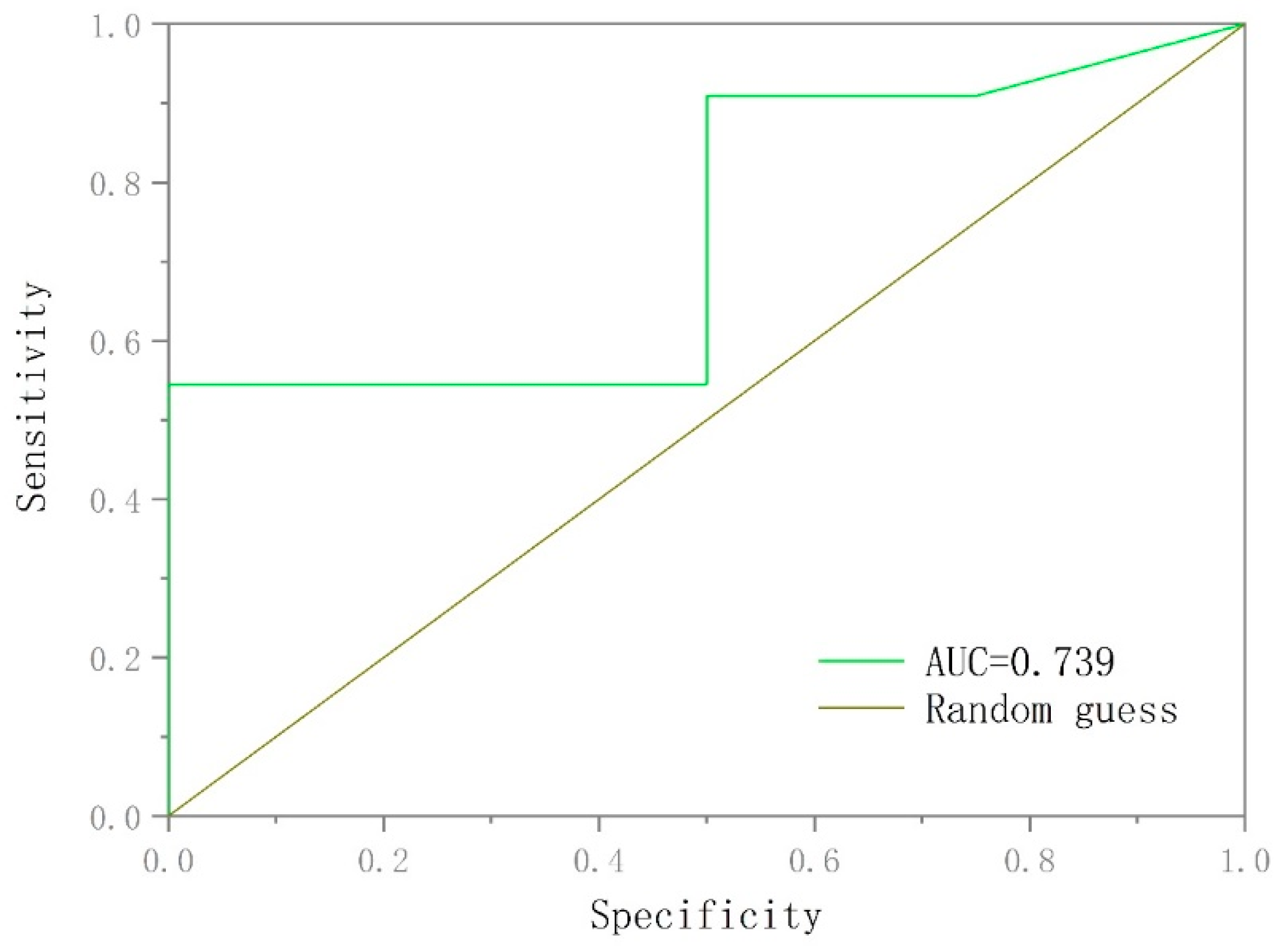
| Conditional Factors | Sources | Format |
|---|---|---|
| Thickness of soft soil stratum | Lunan Geological Engineering Survey Institute of Shandong Province | Tiff |
| Distance to fault | Lunan Geological Engineering Survey Institute of Shandong Province | Tiff |
| Groundwater quantity | Lunan Geological Engineering Survey Institute of Shandong Province | Tiff |
| Groundwater quality | Lunan Geological Engineering Survey Institute of Shandong Province | Tiff |
| Water conservation | Geographical Information Monitoring Cloud Platform (www.dsac.cn accessed on 10 January 2022.) | Tiff |
| Ecological protection | Geographical Information Monitoring Cloud Platform (www.dsac.cn accessed on 10 January 2022.) | Tiff |
| Depth of groundwater | Jining Urban and Rural Water Bureau | Tiff |
| Land use | Jining Natural Resources and Planning Bureau | Tiff |
| Intensity of Importance | Definition | Explanation |
|---|---|---|
| 1 | Equal importance | Two activities contribute equally to the objective |
| 3 | Moderate importance of one over another | Experience and judgment moderately favor one activity over another |
| 5 | Essential or strong importance | Experience and judgment strongly favor one activity over another |
| 7 | Very strong importance | An activity is very strongly favored and its dominance is demonstrated in practice |
| 9 | Extreme importance | The evidence favoring one activity over another is of the highest possible order of affirmation |
| 2, 4, 6, 8 | Intermediate values | When compromise is needed |
| Reciprocals | If the importance of Ai compared to Aj is aij, then the importance of Aj compared to Ai is aji = 1/aij. | |
| N | 1 | 2 | 3 | 4 | 5 | 6 | 7 | 8 | 9 | 10 |
|---|---|---|---|---|---|---|---|---|---|---|
| RI | 0 | 0 | 0.52 | 0.89 | 1.11 | 1.24 | 1.35 | 1.40 | 1.45 | 1.49 |
| Hydrogeological Unit | MGE(104 m3/km2·a) |
|---|---|
| Rencheng | 8.09 |
| Yanzhou | 19.91 |
| Qufu | 10.87 |
| Jiaxiang | 14.07 |
| Zoucheng | 12.69 |
| Wenshang | 27.4 |
| Indicators | Class-III | Class-IV | Class-V |
|---|---|---|---|
| pH | 6.5–8.5 | 5.5–6.5, 8.5–9 | <5.5, >9 |
| Total Hardness (mg/L) | ≤450 | ≤550 | >550 |
| TDS (mg/L) | ≤1000 | ≤2000 | >2000 |
| Sulfate (mg/L) | ≤250 | ≤350 | >350 |
| Cl (mg/L) | ≤250 | ≤350 | >350 |
| Fe (mg/L) | ≤0.3 | ≤2.0 | >2.0 |
| Mn (mg/L) | ≤0.1 | ≤1.5 | >1.5 |
| Cu (mg/L) | ≤1.0 | ≤1.5 | >1.5 |
| Zn (mg/L) | ≤1.0 | ≤5.0 | >5.0 |
| Al (mg/L) | ≤0.20 | ≤0.50 | >0.50 |
| Hg (mg/L) | ≤0.001 | ≤0.002 | >0.002 |
| As (mg/L) | ≤0.01 | ≤0.05 | >0.05 |
| Phenol (mg/L) | ≤0.002 | ≤0.01 | >0.01 |
| Sulfide (mg/L) | ≤0.2 | ≤0.1 | >0.1 |
| NO− (mg/L) | ≤20 | ≤30 | >30 |
| NO2− (mg/L) | ≤0.02 | ≤0.1 | >0.1 |
| Ammonia Nitrogen (mg/L) | ≤0.50 | ≤1.50 | >1.50 |
| F (mg/L) | ≤1.0 | ≤2.0 | >2.0 |
| Assessment indicators | T | D | U | F | Weight |
|---|---|---|---|---|---|
| T | 1 | 1 | 2 | 3 | 0.3647 |
| D | 1/2 | 1 | 1 | 2 | 0.2771 |
| U | 1 | 1 | 1 | 2 | 0.233 |
| F | 1/3 | 1/2 | 1/2 | 1 | 0.1252 |
| CR = 0.0171 |
| Assessment Indicators | Index Classification and Assignment | |||
|---|---|---|---|---|
| 0.1 | 0.4 | 0.7 | 1 | |
| Distance to fault | Stability Areas | Relatively Stable Areas | Lower-Stability Areas | Low-Stability Areas |
| Depth of groundwater | <6 m | 6–8 m | 8–10 m | >12 m |
| 0.1 | 0.55 | 1 | ||
| Land use | Non-construction areas | Dispersed town construction areas | Concentrated urban construction areas | |
| Thickness of soft soil stratum | <20 m | 20–30 m | >30 m | |
| Function | Attribute | Good | Moderate | Poor |
|---|---|---|---|---|
| Resource supply function | Groundwater resource quantity | MGE ≥ 16 × 104 m3/km2·a | Other | MGE < 10 × 104 m3/km2·a |
| Groundwater quality | Class III | Class V | ||
| Geo-environmental stability function | Land subsidence | Low-vulnerability zone | Moderate-vulnerability zone | High-vulnerability zone |
| Ecological environment function | Water conservation | Other | / | Water conservation zone |
| Ecological protection | Ecological protection zone |
Disclaimer/Publisher’s Note: The statements, opinions and data contained in all publications are solely those of the individual author(s) and contributor(s) and not of MDPI and/or the editor(s). MDPI and/or the editor(s) disclaim responsibility for any injury to people or property resulting from any ideas, methods, instructions or products referred to in the content. |
© 2023 by the authors. Licensee MDPI, Basel, Switzerland. This article is an open access article distributed under the terms and conditions of the Creative Commons Attribution (CC BY) license (https://creativecommons.org/licenses/by/4.0/).
Share and Cite
Chen, H.; Tan, X.; Zhang, Y.; Hu, B.; Xu, S.; Dai, Z.; Zhang, Z.; Wang, Z.; Zhang, Y. Study on Groundwater Function Zoning and Sustainable Development and Utilization in Jining City Planning Area. Sustainability 2023, 15, 12767. https://doi.org/10.3390/su151712767
Chen H, Tan X, Zhang Y, Hu B, Xu S, Dai Z, Zhang Z, Wang Z, Zhang Y. Study on Groundwater Function Zoning and Sustainable Development and Utilization in Jining City Planning Area. Sustainability. 2023; 15(17):12767. https://doi.org/10.3390/su151712767
Chicago/Turabian StyleChen, Hongnian, Xianfeng Tan, Yan Zhang, Bo Hu, Shuming Xu, Zhenfen Dai, Zhengxuan Zhang, Zhiye Wang, and Yawei Zhang. 2023. "Study on Groundwater Function Zoning and Sustainable Development and Utilization in Jining City Planning Area" Sustainability 15, no. 17: 12767. https://doi.org/10.3390/su151712767
APA StyleChen, H., Tan, X., Zhang, Y., Hu, B., Xu, S., Dai, Z., Zhang, Z., Wang, Z., & Zhang, Y. (2023). Study on Groundwater Function Zoning and Sustainable Development and Utilization in Jining City Planning Area. Sustainability, 15(17), 12767. https://doi.org/10.3390/su151712767





